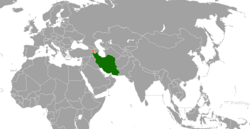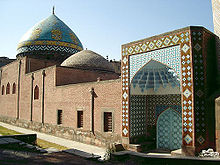Armenia–Iran relations
 | |
Iran |
Armenia |
|---|---|
Bilateral relations exist between
The two nations share their history and culture to a large extent due to their directly interactive relationship going back for thousands of years, starting with the ancient
Stepan Safarian of the Armenian Center for National and International Studies has commented on the Armenia–Iran relationship, stating: "Given this geopolitical environment, Armenia has the legitimate right to cooperate with Iran for ensuring its security... Besides, Armenia has an energy surplus and its only major export market at present is Iran... So there is also a lot of economic interest involved."[3]
Due to the two nations' intertwined history, and with the Armenians having a native presence in what is present-day northwestern Iran for millennia,[4] many of the oldest Armenian churches and monasteries are located within Iran, such as the Saint Stepanos Monastery and Saint Thaddeus Monastery, amongst others. Armenia and Iran also share extensive touristic and trade ties.
Context
Brief history
Iran and Armenia have been in close contact for thousands of years. Since Antiquity there has always been much interaction between Ancient
Armenia was conquered by the
On the
The cultural links between the Armenians and the Persians can be traced back to Zoroastrian times. Prior to the 3rd century AD, no other neighbor had as much influence on Armenian life and culture as Parthia. They shared many religious and cultural characteristics, and intermarriage among Parthian and Armenian nobility was common. For twelve more centuries, Armenia was under the direct or indirect rule of the Persians.[6]
What is now modern day
Nagorno-Karabakh War (1992)
New peace mediation efforts were initiated by the Iranian President,
While Iran had tried to keep the peace between two countries, Azerbaijani leadership had accused Iran for its tacit backup to Armenia, resulting in tensions between Azerbaijan and Iran, and boosting the ties between Armenia and Iran.
Post 1992
In 1994, Armenia shot down an Iranian military plane. Armenia sent a delegation to Iran to apologize. The incident did not prevent the two countries from signing trade deals.[14]
Amid the ongoing
High-level visits
This section is empty. You can help by adding to it. (September 2021) |
Trade
Especially important is the cooperation in the field of
In July 2007, a memorandum was signed on the start of feasibility studies on the ideas of building an Armenian-Iranian railway and a Russian-owned oil refinery that would process Iranian crude. In addition, the Armenian and Iranian governments have been working on a bilateral free trade agreement that could be signed by the end of 2007.[16]
Former Iranian President Mahmoud Ahmadinejad has been quoted as saying "The Islamic Republic of Iran welcomes and supports the development of ties with Armenia in various areas, particularly in energy as well as transportation, sports, and tourism." [citation needed]
Trade relations continue to be strong,[17][18] as trade volume between the two countries increased to US$200 million in 2009,[citation needed] and to US$300 million by 2014.[19]
In 2014, the Iranian and Armenian energy ministers agreed on the construction of a new power transmission line from Armenia to Iran in line with the two country's efforts to boost energy ties.[19]
In June 2015, both nations agreed to start building the 3rd power transmission line. It was expected to be completed in 2018, but work took longer than expected. The COVID-19 pandemic and the Second Nagorno-Karabakh War slowed progress down further. In January 2023, Armenian Deputy Minister of Territorial Administration and Infrastructures Hakob Vardanyan stated that he expected the project to be complete by yearend.[20] Once the project comes on steam, it will almost triple electricity exchange between the two neighbouring countries.[21]
On January 23, 2021, Iran and Armenia signed a memorandum of understanding (MOU) to expand trading relations between the two countries.[22] The MOU was signed by the Armenian Economy Minister Vahan Kerobyan and the Iranian Industry, Mining and Trade Minister Alireza Razm Hosseini, in Tehran.[22] Accordingly, sectors such as the mining industry, foodstuff, and home appliances are in the main focus that provide ways for the two countries to establish mutual cooperation.[22]
Tourism
Armenia and Iran share extensive touristic ties. About 35,000 Iranian tourists visited Armenia in the first half of 2014, of a total of 495,967 tourists that had come to Armenia in the first half of 2014.[23] This showed an increase of 17.3% compared to the same period last year.[23] In 2014, Iran ranked 4th in the largest number of tourists that visit Armenia, behind Russia (44% of the total number of tourists), Georgia (28%), and the EU (Germany, France, Italy and Scandinavia). As of 2014, Iranian tourists amounted up to 7% of the total number of foreign tourists visiting Armenia.[23]
The number of Iranian tourists visiting Armenia had been steadily on the rise for years, and the two nations have already unveiled plans to sign a memorandum on cooperation in the field of tourism.[23]
"Iran is an important market for us. This country is not only our neighbor, but we have good neighborly relations with it, which is important for the sphere."
– Head of the Department of Tourism at Armenia's Ministry of Economy Mekhak Apresyan, July 2014.[23]
Cultural ties
Iranian
Due to the very long intertwined histories, many of the millennia- and century-old

In recent years, Iran's cultural attaché to Armenia, Reza Atufi, has announced that the two countries have reached a preliminary agreement to make a joint television series. He said that the joint venture would portray the social and cultural life of Iran and Armenia and expand cinematic ties between the two countries.[26]
Iranian-Armenians
The Armenian diaspora in Iran is one of the biggest and oldest Armenian communities in the world, as well as the largest
The remaining Armenian minority in the Islamic Republic of Iran is still the largest Christian community in the country, ahead of the Assyrians.
Diplomacy
See also
- Persian Armenia
- Treaty of Turkmenchay
- Erivan khanate
- Abbas Mirza Mosque, Yerevan
- List of ambassadors of Iran to Armenia
References
- ISBN 1598849484
- ^ Moniquet, Claude; Racimora, William (17 January 2013). "The Armenia–Iran relationship" (PDF). European Strategic Intelligence & Security Center. Retrieved 22 September 2023.
- ^ "Armenian President interested in expansion of cooperation with Iran". IRNA English. 26 October 2012. Retrieved 20 November 2020.
- ^ a b Golnaz Esfandiari (23 December 2004). "A Look at Iran's Christian Minority". Payvand.com. Retrieved 21 March 2012.
- ^ A. Bruke, V. Maxwell, I. Shearer, Iran, Lonely Planet, 2012
- ^ Sanasarian, Eliz. "Religious Minorities in Iran" (PDF). Archived from the original (PDF) on 16 June 2015. Retrieved 23 October 2015.
- ^ ISBN 1598849484
- ^ Fisher et al. 1991, p. 329.
- ^ Dr. Mahmood Vaezi. Vice-President of the Center for Strategic Research and Head of Foreign Policy Research. "Mediation in the Karabakh Dispute". Center for Strategic Research. Archived from the original on 22 July 2011. Retrieved 6 May 2010.
{{cite web}}:|author=has generic name (help) - RFE/RL. Retrieved 6 May 2010.
- ^ Важный документ по Карабаху или ничего особенного? [An important document on Karabakh or one of no significance?]. Vremya Novostei (in Russian). 11 June 2008. Archived from the original on 29 May 2010. Retrieved 1 May 2010.
- ^ "Will Azerbaijan Join the Anti-Iran Coalition?". 16 July 2019.
- ^ Giragosian 2017, p. 21.
- ^ Dara Conduit, Shahram Akbarzadeh, ed. (2016). Iran in the World: President Rouhani's Foreign Policy. Palgrave Macmillan. p. 62.
- ^ Iranian Foreign Minister: Iran-Armenia border must remain unchanged
- Radio Free Europe. Retrieved 19 January 2008.
- ^ "Exclusive: Iran looks to Armenia to skirt bank sanctions". Reuters. Archived from the original on 17 April 2023.
- ^ "Armenia Deepens Ties With Embattled Iran". EurasiaNet.org. 27 July 2006. Retrieved 14 December 2017.
- ^ a b Iran, Armenia Form Commission to Boost Trade Retrieved 18 June 2015
- ^ "Armenia hopes to complete energy project with Iran in 2023". Armenpress. 20 January 2023. Retrieved 2 January 2024.
- ^ Iran, Armenia to start building 3rd power transmission line Retrieved 18 June 2015
- ^ a b c "Iran, Armenia ink MOU on expansion of trade ties". Tehran Times. 24 January 2021. Retrieved 13 May 2021.
- ^ a b c d e "More Iranian Tourists Travel to Armenia" Archived 22 July 2015 at the Wayback Machine retrieved July 2015
- ^ ARMENIA AND IRAN iv. History, discussion, and the presentation of Iranian influences in Armenian Language over the millennia
- ^ "Armenian Monastic Ensemble of Iran"
- ^ "Iran and Armenia to collaborate on TV series". Mehr News Agency. 26 August 2007. Retrieved 8 October 2022.
- ^ H. Nahavandi, Y. Bomati, Shah Abbas, empereur de Perse (1587–1629) (Perrin, Paris, 1998)
- ^ "Armenia in the Age of Columbus". Archived from the original on 3 March 2016. Retrieved 23 October 2015.
Sources
- Fisher, William Bayne; Avery, P.; Hambly, G. R. G; Melville, C. (1991). The Cambridge History of Iran. Vol. 7. Cambridge: ISBN 0521200954.
- ISBN 978-1498564960.
External links
- Embassy of Armenia to Iran
- Embassy of Iran to Armenia
- ARMENIA AND IRAN iv. History, discussion, and the presentation of Iranian influences in Armenian Language over the millennia
- Series of several large articles that cover thousands of years of Iranian-Armenian relations in pre-modern times
- ARMENIA AND IRAN vi. Armeno-Iranian relations in the Islamic period


